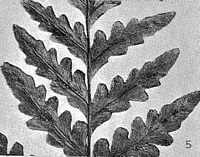|
 Uredo histiopteridis Uredo histiopteridis
SynonymsMilesina histiopteridis
Milesia histiopteridis
BiostatusPresent in region - Indigenous. Non endemic
Images (click to enlarge)
Caption: FIG. 101. Milesina Histiopteridis G.H. Cunn. Uredospores and peridial cells (b) from
Histiopteris incisa (Thunb.) J. Sm. | 
Caption: FIG. 5.-Milesina Histiopteridis G.H. Cunn. Ziredosori on Histiopteris incisa (Thunb.).J.
Sm. The white spots consist of numerous uredospores which have exuded from the
immersed peridia. |
Article: Cunningham, G.H. (1924). The Uredinales, or rust-fungi, of New Zealand: supplement to Part 1; and Part 2. Transactions and Proceedings of the New Zealand Institute 55: 1-58 Wellington:.
Description: II. Uredosori hypophyllous, scattered, or more commonly crowded in groups which are linear,
intercostal, and up to 15 mm. long, seated on irregular discoloured spots visible on the upper
surface, 0.25-0.5 mm. diam., orbicular, bullate, covered by the epidermis, opening by an
irregular apical pore. Peridium flattened-globose, ostiolate, composecl of obovate, hyaline
cells, outer wall coarsely and densely verruculose. Spores obovate, elliptical, or polygonal,
18-26 X 14-18 mmm.; epispore hyaline, moderately and finely verrucose, 0.75-1
mmm. thick, cell-contents colourless, vacuolate; germ-pores indistinct.
III. Unknown.
Notes: The very thin, moderately and finely verrucose epispore serves to separate this from other
species of the genus. The .rust is exceedingly common in the localities where it has been
collected; in fact, scarcely a frond could be obtained free from the dead areas in which the
uredosori are embedded.
|